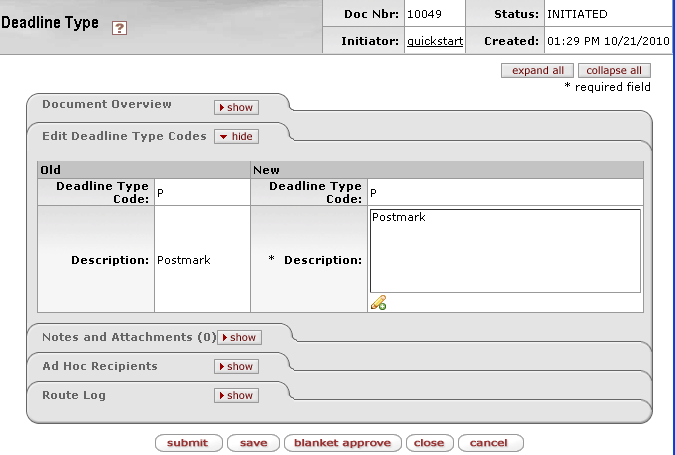Deadline Type
The Deadline Type maintenance document exists to give you a way of creating deadline type codes used in the development of proposals. It is used to establish and maintain numeric codes and textual description values which are stored in database tables. This data serves as reference information that is made available for display and selection in various areas of the system, including other e-docs. For example, deadline types are used in proposal development, and indicate if the deadline is based on the postmark, receipt date, or a target date. Deadline Types are captured in the Proposal Development e-doc Proposal page, in The Sponsor & Program Information section.
Document Layout

Figure 896 Deadline Type Maintenance Document Example Layout
Edit Deadline Type Codes Section
The Edit Deadline Type Codes section of the Deadline Type maintenance document is a unique section that allows you to specify and maintain the details associated with the reference table record in fields.
Table 570 Deadline Type Maintenance Document - Edit Deadline Type Codes Section Field Descriptions
|
Field |
Description |
|
Deadline Type Code |
Required. Enter a deadline type code that the system will use for reference and identification of this deadline type. This may be a single or multiple alphabetic or numeric character(s). |
|
Description |
Required. Enter text
that is the commonly-used name of this deadline type. Click the
add note |
Examples

Figure 897 Deadline Type Maintenance Document Example Values
Common Features
This maintenance document includes the following features that are common to most KC maintenance documents:
Table 571 Links to Common Maintenance Document Component Instructions
|
Common Maintenance E-Doc Component |
Cross-Reference Links To Usage Instructions |
|
Document Header |
|
|
Document Overview Section |
|
|
Notes and Attachments Section |
|
|
Ad Hoc Recipients Section |
|
|
Route Log Section |
|
|
Action Buttons |
|
Process
|
|
For information about searching for, initiating, editing, copying, submitting, saving, closing, canceling, and/or routing a maintenance document, see “Common Maintenance E-Doc Operations” on page 129 in the Overview section. |
 icon
to view/edit/paste text in a new browser window, then click the continue
button to return to the text entry field in the
document.
icon
to view/edit/paste text in a new browser window, then click the continue
button to return to the text entry field in the
document.